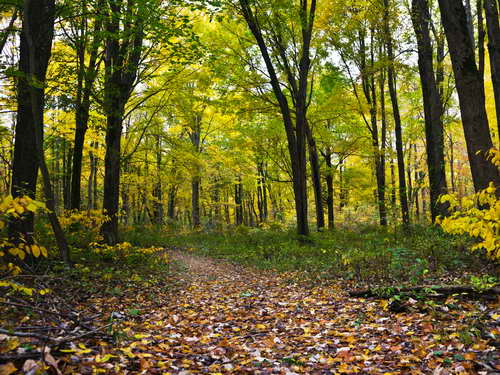The Issue
Addressing contentious issues are part and parcel of the work that Municipal Council performs on a regular basis. The majority of issues they confront are fairly mundane; important to those that they affect, but largely not rising to the attention of the larger population. However, Chatham-Kent’s council will soon be confronting, again, the boisterous issue of whether or not to pass a by-law that would permanently limit the ability of landowners to clear-cut woodlots, while safeguarding them for the future.
In 2014, Council initially addressed how woodlots within the Municipalty should be managed. They developed a “Natural Heritage Strategy” that would be overseen by Council and other stakeholders. This would promote, among other things, the protection of woodlots, and work to increase the amount of tree cover in the community overall while addressing other environmental issues as well.
The end result was a document that was largely ignored. As the years went by, Council and Administration essentially forgot it existed. Most of the important data gathering and preservation based initiatives which were written into it were not finished or even begun. This much is clear to see by reading the Municipalities’ own “how did we get here” report.
Candid Badger has always been interested in free and open debate when considering different sides to issues. Where we have taken a stand, as in our previous clear-cutting article, we have endeavoured to treat opposing viewpoints with respect while accurately representing them. As the clear-cutting by-law issue will once again be coming to Council in the next few weeks, it seemed prudent to collect viewpoints on this issue from a large share of our Councillors as possible.
In this respect, we have failed.
The Process
Each councillor received an email detailing what the process would be. Candid Badger would send them three questions, via email. They would have time, at least a week, to compose a thoughtful response to each question. Councillors were even encouraged to disagree with the premise of the question if they wished.
They were assured that their responses would be collected, edited for clarity if needed, and then sent back to them so that they could approve the final version. In essence, we wanted them to have the opportunity to clearly define their positions to the issues brought up by the questions, without any commentary or interpretation on our part.
Councillors Harrigan, Hall, B. McGreggor, Latimer and Bondy agreed to answer the questions. Councillors Kirkwood-Whyte and Wright asked to see the questions first, which we agreed to. Councillor Cecacci wished to only comment through a conversation, not email, which we respectfully declined. All of the other councillors ignored the email.
As you will see, Candid Badger received responses from Councillors Hall, B. McGreggor, Latimer, Bondy and Kirkwood-Whyte. We appreciate that they took the time to respond, as it is vital to any free society that the elected officials willingly communicate with the citizens.
However, we are extremely disappointed that nearly ⅔ of our elected officials chose not respond.
It is our hope at Candid Badger that you will find this helpful and enlightening as Council goes back into debate around this subject. Should you wish to contact one of your local council members, you can find their contact information here.
The Questions
While not answering the questions specifically, Councillor Kirkwood-Whyte sent this response:
Frequently, when considering how to vote in a particular issue, I begin with a particular “gut feeling” about what is true, what is fair, what will build goodwill and what will be beneficial – elements of the Rotary “Four Way Test”.
You are correct when you say that this is a very controversial issue. And whatever decision is ultimately made, may not be “beneficial” to all concerned.
On this, as in other matters, I have chosen to keep an open mind, listen to all sides and “trust the process”. In fact, I have already devoted numerous hours to reading, speaking with, and talking to local residents who stand at various positions along the continuum of “for” or “against” a tree-cutting bylaw.
It is just too early in the Natural Heritage conversation to be definitive about what decision will be “beneficial to all – or most – concerned”. And my opinion, at this point, carries more weight if I encourage others to do the same – that is, to keep an open mind.
What I do believe, however, is that our community of Chatham-Kent has a responsibility to contribute, locally, to the global conversation on the impacts of climate change.
I’m looking forward to the scheduled meetings of the Natural Heritage Committee of the Whole including updates on the “mapping” exercise and hearing the numerous deputations on the subject as we move forward in our current discussions.
Question 1
Forests are more than “trees.” A forest is a complex biological system that deepens over time. It takes decades to establish the diversity found within a forest which provides habitat for rare and endangered species and a buffer against flooding, water pollution, and soil erosion. Established forests also work to lower local hot temperatures and have been linked to improved mental health for nearby communities. New plantings of trees, even in large quantities, will take decades to replace that which is lost when an established forest area is removed.
How do you weigh the benefits that a few individuals receive from removing a natural resource against the permanent harms done to the environment and loss of benefits to the community as a whole?
Councillor Bondy
I believe there has to be a balance. I don’t fall, particularly, on one side of the issue or other. I’ve spoken to a lot of farm owners. The vast majority are good stewards of the land and they do not intend on cutting down the existing woodlots. Where I believe the problem lies is when multinationals but up these smaller farm operations and are completely profit-driven and they are not local. So that is where the debate should start.
I do understand that these woodlots are irreplaceable in the context of decades. I believe we have an obligation to protect the woodlots, and with that, I believe that needs to be coupled with some sort of compensation to the woodlot owner. That could be a tax reduction or a monetary incentive. The Municipality has the power to do that to some degree, and also the obligation to do that.
If we make it financially rewarding to preserve woodlots, then a woodlot owner will do so.
Councillor Latimer
Lack of agreement upon this definition of social “balance” between environmental
sustainability and benefit to the community of the whole is the crux of our current community divide. There are many who feel that the implementation of a tree-cutting bylaw/regulation is the “only” way to ensure that landowners cannot exploit the land for their individual benefit.
Chatham-Kent land currently makes up almost 4.2% of the 5% of remaining arable land across all of Ontario. This arable land supports everyone who lives in Chatham-Kent, this province Ontario, this country Canada, this world our planet. There is no science-based data that supports nor states that the most internationally productive non-irrigated land/acreage should have extended tree cover. There is significant science-based data that support and states that proper use of soil preservation techniques, appropriate soil structure management, crop rotation and minimal tillage contributes to environmental sustainability by producing oxygen, sequestering carbon, cooling the earth and anchoring the earth, assisting with soil sustainability, erosion control and nutrient management/run-off.
It is also worthwhile noting that Ontario as a province currently has 66% tree cover, over two times the federally suggested provincial tree cover standard of 30%. CK “grows food for the world” using science-based sustainable farming practises that enable maintenance of complex biological soil systems that also provides animal habitat, supports pollination and act as a buffer against flooding, water pollution and soil erosion.
Councillor Hall
Striking that balance is one of the primary tasks for the new Natural Heritage Committee of the Whole. Since bringing the original motion forward in the spring, throughout the public consultation process and now as we get started with the newly formed committee, we’ve heard a wide spectrum of opinions, points of view and feedback on the topic of natural heritage in Chatham-Kent. We need to ensure that the community’s voice is heard, best practices are examined and ultimately that a Chatham-Kent stamp is put on the policies surrounding natural heritage moving forward.
Environmental sustainability is a priority for this term of Council and this is an opportunity for us to engage in work and create policies that will be meaningful and long-lasting for future generations.
Councillor B. McGreggor
It is important that we make a commitment to sustainability and look for ways to balance the priorities of stakeholders – stakeholders include not just current landowners, but also our future generations, and the indigenous groups whose traditional lands we are currently living on. A responsible approach that allows for property maintenance, sustainable tree harvesting, and recreation but prohibits clear-cutting large areas is a reasonable approach to balancing interests.
Question 2
One of the largest objections to a by-law is that it would limit a land owner’s ability to use their property as they see fit. However, there are already zoning laws in place across the Municipality that limit property use. Those who live in urban areas are subject to more zoning and by-laws than those in rural areas. Most of these types of laws are passed because the benefit to the larger society is greater than the harms the limitations place over the individual.
Why do you believe that a clear-cutting by-law would (or would not) be a greater benefit to the whole community than the harm done by putting new limits on property rights in this very specific situation?
Councillor Bondy
Naturally, its a greater good to the overall community to not allow clear-cutting of a woodlot. But, the question here is “how far do we infringe on individual people’s property rights for the greater good. It’s a big philosophical question, and not with an easy answer.
The argument will be, from the woodlot owners, “What’s next? Are you going to say, ‘well now we want to take 10% of your farmland and make it forest because that’s a greater good to the community?’” This is why it’s a really tricky question. Obviously, the greater good is important, but we do live in a free and democratic society with John Locke’s property rights firmly in place where people have the right to do what they will with their land if it’s not harming the greater good.
Cutting down woodlots does harm to the greater good, but not to the degree that is catastrophic and is going to change the climate situation in the world. When we talked about limited tree coverage in Chatham-kent, anywhere between 1.5% and 5% depending on whose study you look at, we have extremely low tree coverage. When you go to Northern Ontario the tree coverage is by far much greater than the national average. Focusing in on Chatham-Kent and its tree coverage is an unfair assessment. We are an agricultural community. We grow food. So which is more important-food or trees?
Is the greater good better off by growing more food or by maintaining woodlots? I support maintaining woodlots, but if there is a piece of very fertile land and somebody wants to cut out 20% of it to increase the yield on their crops, then I am probably going to think that that’s ok.
A bylaw should not be a blanket bylaw that affects everybody equally. I think it should be a permit-based by-law. If an owner wanted to cut a woodlot or a portion of a woodlot, the owner would have to come to the Municipality, have an assessment made at their own cost, and let Council determine if this is a good idea based on the environmental impact.
I do think it’s a case-by-case analysis. I believe a permit-driven bylaw would be the way to go.
Councillor Latimer
I do not agree with the statement: ”Those who live in urban areas are subject to more zoning and by-laws than those in rural areas”, particularly with regard to farming and/or agricultural-based industry properties.
These farming/agricultural operations are required to meet an ever-increasing number of strict federal and/or provincial government mandated best practise environmental standards, without associated increased cost coverage. Without demonstrated proof of standard compliance, these rural landowners/farming operations/agriculturally based industries cannot sell their products and remain sustainable or in business. Agriculture has moved forward with the environmental farm plan to update many Best Management Practises (BMP’s) for sustainable agriculture.
I do not believe that a clear cutting bylaw that puts new limits on the rural property owner’s rights would be a greater benefit to the whole community. Sixty-seven percent of our Chatham-Kent tax base is our rural property owners. Many are multi-generation farm operators who continue to be the largest contributor to our national GDP. Their land value remains their main financial asset or investment, which if not sustainably cared for, obviously devalues. Our rural landowners are responsible citizens who take care of their land and their neighbours through sustainable science-based agricultural practices.
Land is always for sale. Perhaps those individuals who do not understand science based agricultural practises should consider buying land to enable the planting of any number of desired trees. While this is an unsustainable legal practise at least the land ultimately remains available for future agricultural use. Unlike the current growing urban housing development scenario, where irreversible environmental impacts are occurring at increasingly far faster rates than tree cutting acreage loss.
Councillor Hall
Based on lessons learned from 2013-2014, when the topic was last on the Council agenda, I felt it was essential to ensure regulation was in place while Council, staff and the community discussed the topic of natural heritage. I strongly believe that putting the temporary by-law in place was the correct decision by Council, as it created a safe place for Council to discuss the matter with each other, the public and with staff.
As the newly elected chair of the Natural Heritage Committee of the Whole, I committed to keeping an open mind, being prepared and ensuring the public’s and committee members’ thoughts are heard while maintaining a balanced approach.
In the original motion approved by Council, we directed staff to revise and update, for Council’s consideration, the by-law from February 11, 2013. I believe this gives the committee a good starting point to work from when tackling the regulation issue. However, this by-law was always meant to be temporary. I’m looking forward to having a healthy discussion and providing direction on a long-term Chatham-Kent solution.
Councillor B. McGreggor
Municipal zoning and regulation has long existed to regulate permissible use of property. Chatham-Kent is one of only two municipalities without regulation putting limits on clear-cutting activity. It is a reasonable step to join the rest of Ontario in that practice while making sure we are providing opportunity for landowners to continue to maintain their property, use their woodlots for sustainable commercial use, and enjoy them recreationally. There are current programs to incentivize preservation, and we should lobby the provincial government to change current limits on tax exemption for forested areas on farms. A tax exemption for forested areas on agricultural land should not have a maximum acreage component as currently dictated by the province.
Question 3
The Natural Heritage Strategy has proven to be a failure. The administration’s own 2021 report illustrates that nearly every meaningful item was either not started, or not followed through. In the past, the LTVCA itself provided numbers that artificially inflated tree cover percentage by including land that is not part of the Municipality. The number of trees and the amount of tree canopy are often wrongly included in any discussion about a clear-cutting by-law.
In what ways do you believe that the Natural Heritage Committee of the Whole will “do better” than the original strategy adopted in 2014 and provide for greater transparency and focus on individual issues that may be related to each other, but are in fact, separate?
Councillor Bondy
We will have to wait and see where this one goes. Last time it was a really hot and contentious issue. This time it seems to have calmed down, which is good because calmer minds are prevailing. Last time it became very emotional and very political, this time there seems to be a little more calmness to the conversation.
Is it really going to be more successful than the original document? Probably not. The original document was a failure, we chickened out on it. My hope is that we come up with a definitive policy or bylaw that we, as Council, then enforce something with teeth. We didn’t do that last time. We skirted it, went around it.
When we talk of the “Committee of the Whole,” that’s just a nice way of saying “unofficial Council,” because all of Council is there but it’s not Council it’s “Committee.” Iit’s really one big council meeting.
The committee of the Whole has only met once, so it’s impossible to say if it’s better because it hasn’t really begun. Will it be better, in a speculative way? No, I don’t think so. I think it’s a chicken way to do this. We did this last time. The by-law came to us and we didn’t pass it and we didn’t deny it. We just came up with a policy that had no teeth-this is the document you are talking about. The short answer is, we can’t do much worse.
Councillor Latimer
Council to date has not received any data to support the belief that the 2014 Natural
Heritage Implementation Strategy (NHIS) has proven to be a failure. From the LTVCA and
the Kent Farmer’s Association perspective, the NHIS was a huge success; it allowed for 8
million in funding to be filtered through the LTVCA which enabled many trees to be planted
and new wetlands to be established.
I do believe that the municipality and Council(s) since 2014 have failed to communicate
what part of the NHIS has been completed and what was not been completed by who and
why. This lack of accountability and minimal transparency has led to the current
misinformed divisive state we find ourselves in now.
It is our job as Council of the day to collect complete and accurate data in order to interpret
and communicate what parts of the NHIS worked well, what parts still need to be
addressed, updated or modified and to identify if any additional components should be
considered. This will assist in determining what actions are to be implemented by who, how
Council will continue to receive ongoing Natural Heritage evaluation/program updates, under
what time frames and through who/which community partners and/or municipal
departments reports will be received.
Councillor Hall
The new Committee of the Whole will be discussing the Natural Heritage Strategy and we’ll be receiving a presentation from the Lower Thames Valley Conservation Authority at the second committee meeting on Monday, November 29, 2021. During this meeting, we’ll also be discussing some of the past and ongoing community-based efforts aimed at enhancing the natural environment through stewardship programs and partnerships, along with an updated natural heritage mapping analysis. The committee will have the opportunity to weigh in on all of
this during the next meeting, and moving forward during the process. I hope and anticipate that the committee will include, among its recommendations, to create an advisory committee of Council starting with the next term of Council, focused on natural heritage. This will add a layer of accountability and transparency, which will ensure the goals and objectives are being met. This is a piece that was missing, in my view, from the previous strategy.
Councillor B. McGreggor
The Natural Heritage Committee of the Whole should not be viewed as an alternative to a clear-cutting by law, but rather as an opportunity to fully discuss and explore ongoing options to stabilize and increase tree cover and natural environments within Chatham-Kent. While a clear-cutting bylaw is an important aspect of preservation and sustainability, it is a stand-alone issue – one of many practices required in a strategic effort to promote sustainability. Other pertinent issues including incentivizing tree planting and naturalization efforts, and protection and maintenance of trees on Municipal property also require discussion and relevant policy development.
So, there you have it, folks. Candid Badger hopes that this will be enlightening and usefull. We need people to participate, and we need elected officials willing to communicate. Please, if you pursue this farther with the Councillors or others in the community, please rememer to be polite.
There are already too many people out who feel bullying and bullshitting is the best way to get what they want. Don’t be like them. Listen to the other side, then converse with facts, logic and kindness.








Councillor Latimer seems concerned that Chatham -Kent needs all the agricultural land it can get and that justifies the loss of our woodlots. He should be asked what his view is on all the urban sprawl that is taking place in our municipality swallowing up vast areas of prime agricultural land. Is Mr. Latimer up in arms about this on going practice? Why is he not pushing for high rise complexes which would leave a much smaller foot print on our so valuable soil?